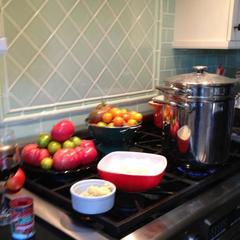Here's my take on hungarian stews and how they relate... Goulash is rather thin stew and is not thickened with anything other than stewed onions, paprikash is considerably thicker with emphasis on paprika (and sometimes peppers) and can be thickened either with cream or flour (sometimes both) and pörkölt (perkelt in neighbouring slavic countries) is even thicker and can be thickened. All of them can be prepared with a variety of main ingredients, but mostly goulash is made out of meat and poultry, paprikash is made with virtually anything (meat, poultry, fish, even mushrooms) and pörkölt is as far as I know made with meat and fish. All of them have a base of stewed onions onto which main ingredient is added (caveat, the example of old-timey paprikash is the only example I've seen with browning step of the main ingredient*), stewed and then are spices and liquid added, and simmered. At the end stew is thickened (interesting method is mixing in the flour in cream before adding). Usual additions to those stews are either cubed potatoes or nokerdli (small hand torn pasta, not unlike spätzle). Interestingly, I think if starch component is added the thickness gets reduced (stew gets more 'soupy'). The liquid traditionally being added is almost always water. If wine is added along it becomes something new- e.g. Weingulasch or vinski gulaš, and becomes thinner (but this maybe belongs into the next paragraph about 'exported versions').
As they moved abroad (particularly to neighbouring countries from which they launched their expansion) funny things happened- while their nature (how they're prepared) stayed the same the thickness changed dramatically. Original goulash is as thin as something called goulash soup (Gulaschsuppe, gulaš juha) outside of Hungary, and when moving abraod it became as thick as paprikash if not even thicker. What most people outside of Hungary think as goulash (the 'exported version') is much closer to pörkölt than to original goulash. Paprikash stayed much the same since it is quite versatile and can be made in variety of 'thicknesses' (from quite thick to quite thin). Sometimes paprikash is served with pasta (tagliatelle would be close enough) that was covered in cream before serving.
* mind you, a good and attentive cook will prolong stewing the main ingredient and onions until all, literally all, water has evaporated and then proceed to brown them- this step is vital with pörkölt, but benefits all of them so it best not be omitted
P.S. sorry for longish post and please take everything I wrote with a grain of salt- I'm no expert on Hungarian cuisine, but my parents lived for a while in a part of Croatia close enough to Hungary. Recipes to follow.




